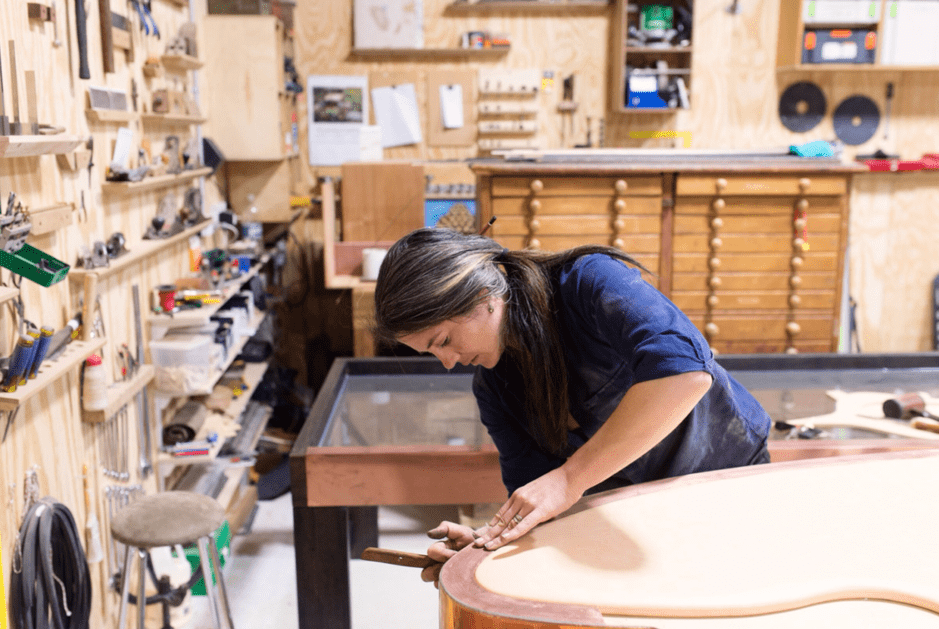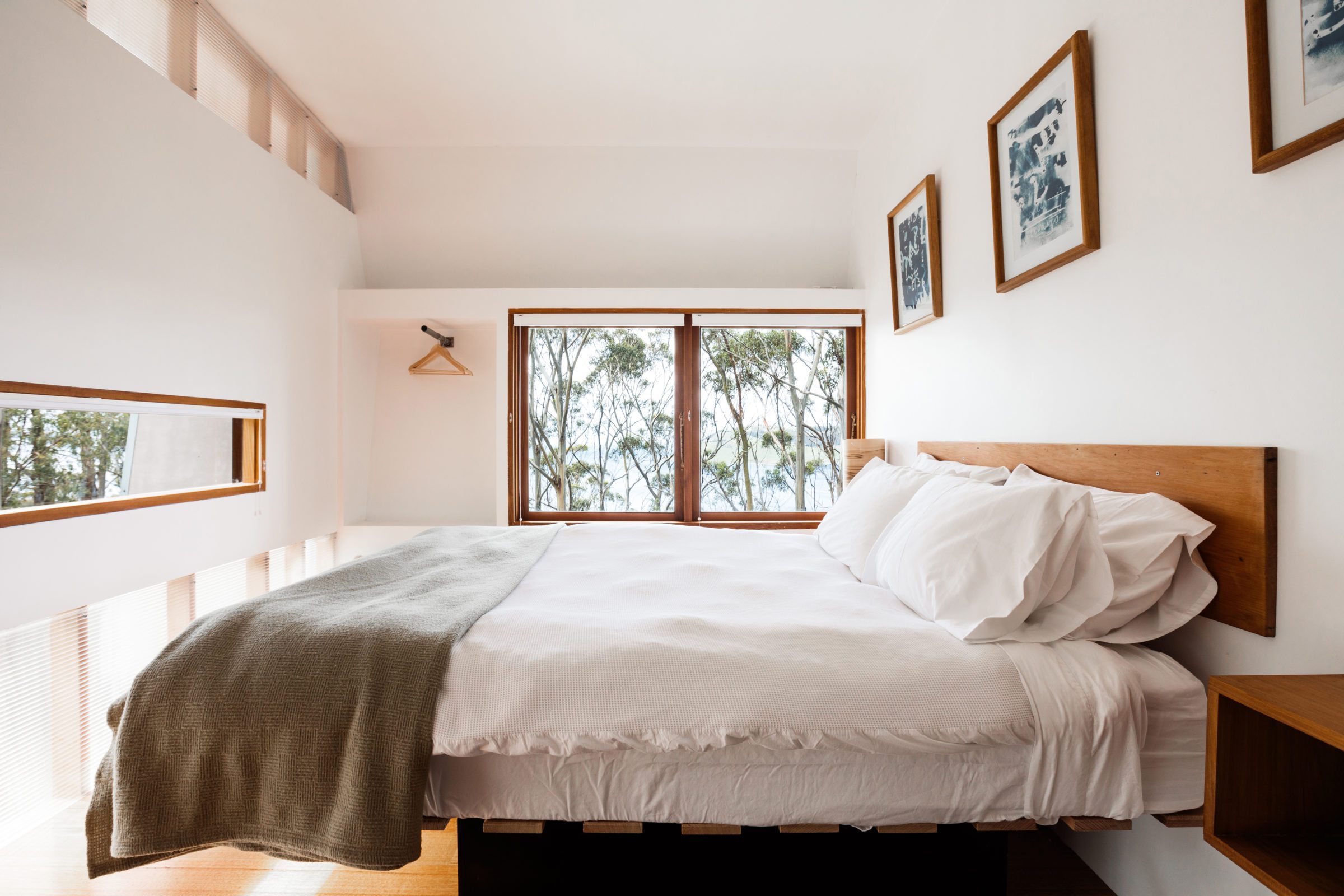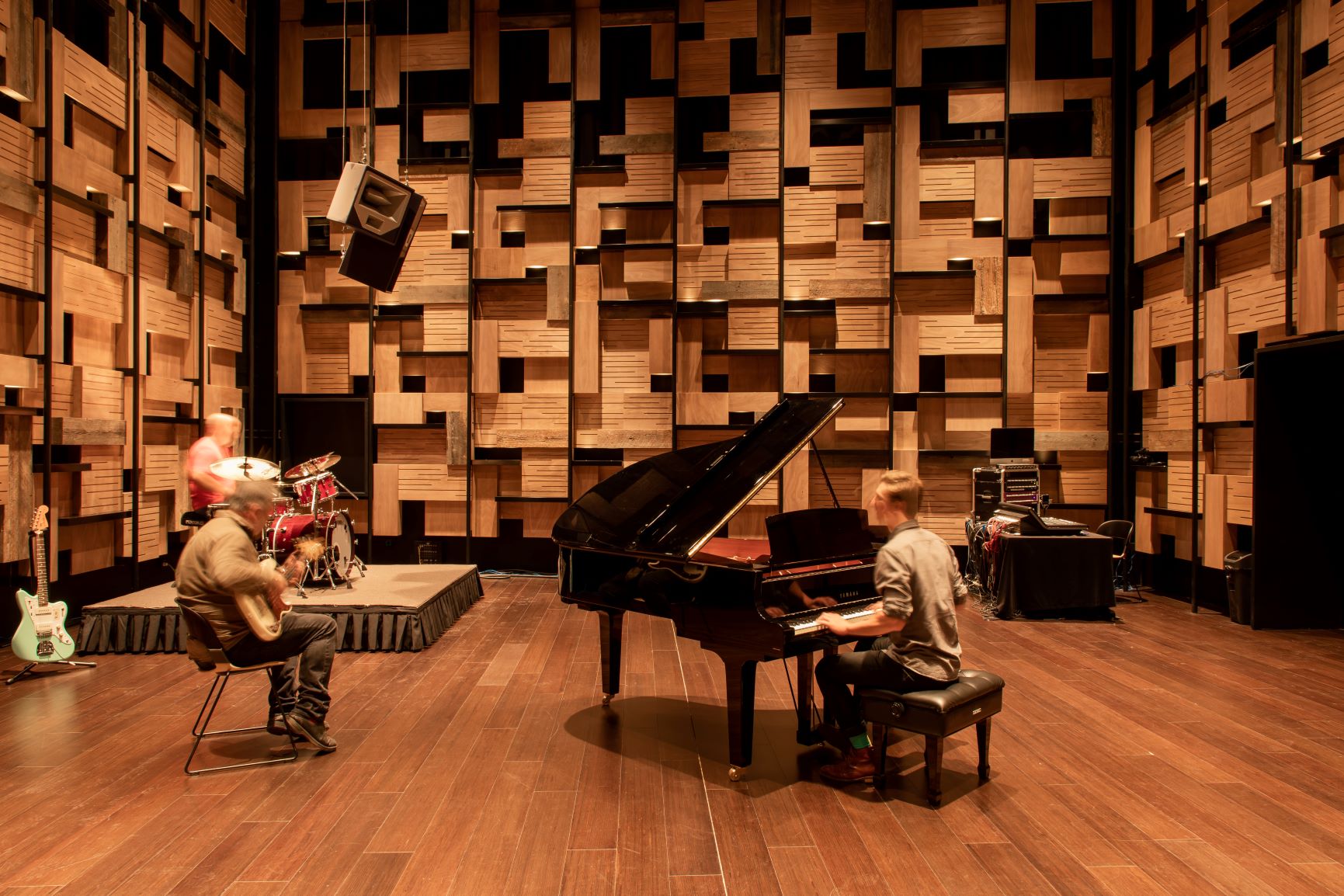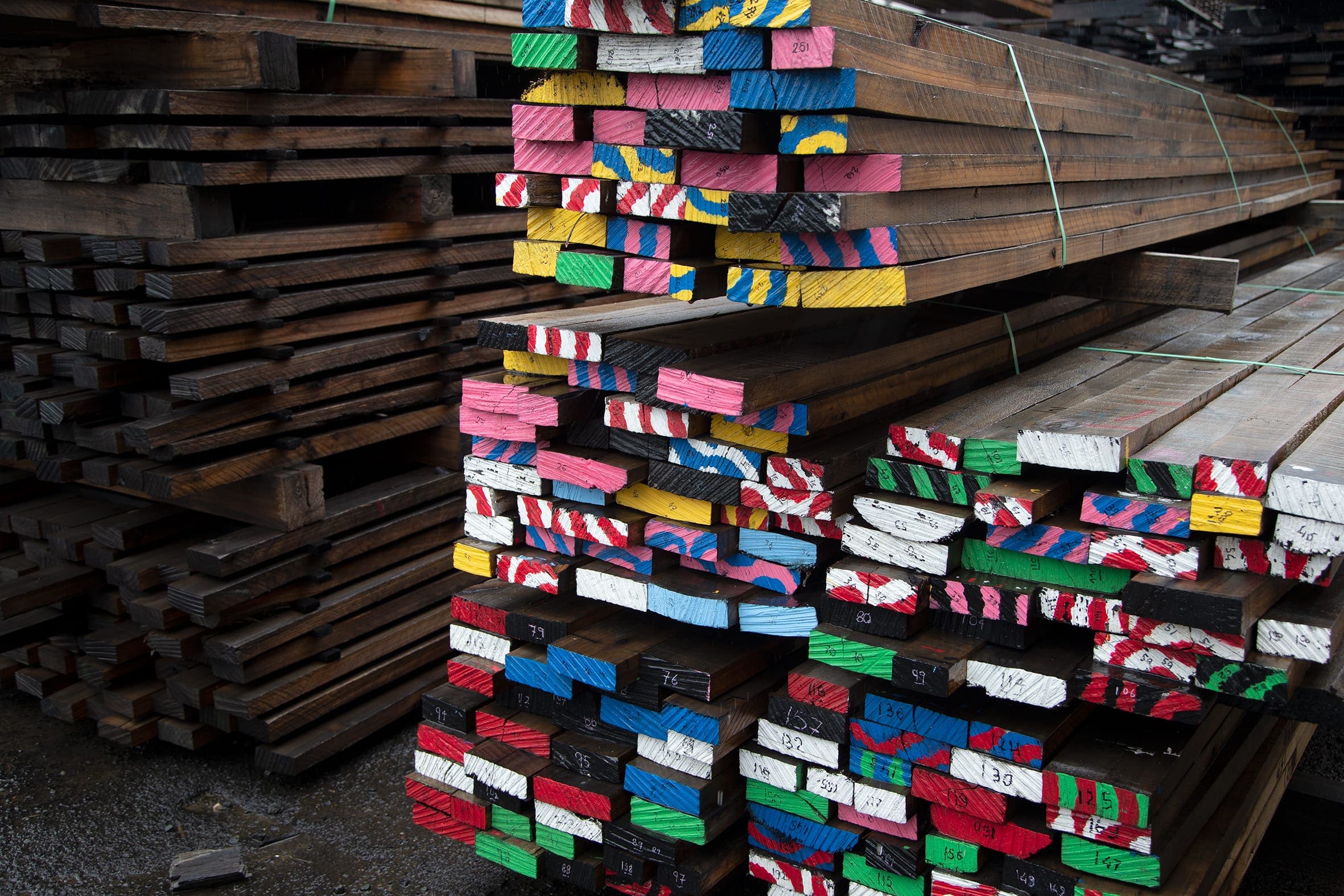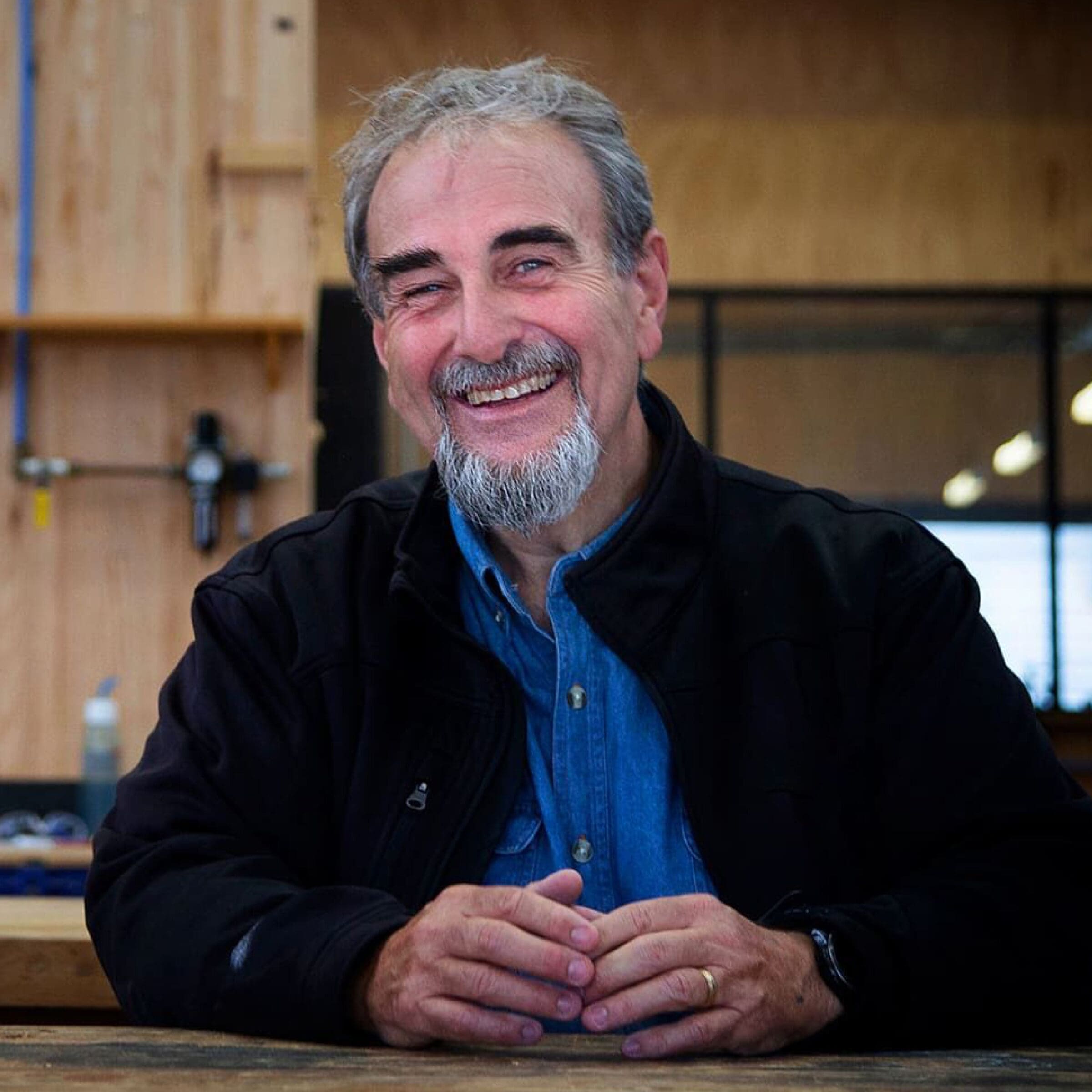The Lady in the White Ute talks Tasmanian Timber
Laura McCusker Furniture was established in 1996 under the flight path as she documents, in Sydney’s gritty, industrial inner-west. Since relocating to Hobart in 2003 she and Peter Howard have continued to make quality hand made, bespoke pieces tailored to their clients’ specific needs.
Whether the brief be to craft an exquisite cheese trolley to delight and intrigue, or to create a timeless rocking chair from hand picked timbers, Laura can do it all.
Working next to a babbling brook, surrounded by heirloom fruit trees, in an old apple packing shed – we were lucky enough to steal a few minutes of this innovative designer’s time to chat about all things Tasmanian Timber.
When you are designing and styling with timber, what textures and materials do you choose to incorporate and why?
Well, Tasmanian timber just makes sense to me. For a wide range of reasons, from the value and the fact that it doesn’t make any sense to be importing timber when we have such great resources at our fingertips.
Tasmanian Oak when I first moved to the state seemed to be under-appreciated in the design space, it was being used for fencing!! When on the mainland it was overpriced, here it was undervalued. Seemingly the way for Taswegians, we take what we have for granted, whether it be our abundance of nature, fresh air or sustainably sourced beautiful timbers. In current times I’ve noticed there is an increasing demand, whenever I post a photo (on Instagram) using Tasmanian Oak in my pieces my international friends almost fall over themselves looking at the beauty of it.
Can you talk to us about any projects, past or present that stand out to you from a design point and why?
That’s a hard one because the most recent ones are always at the forefront of your mind. Between deadlines and mad periods of producing I can forget about the scale, scope and variety of projects that we’ve done when I look through our portfolio. We’ve recently had a client approach us after seeing the really simple outdoor furniture, chairs in fact that we made for Mona almost 10 years ago. So that stands out to me, the simple Tasmanian Timber chairs that are in such a high traffic place, outdoor in Tasmanian weather getting an absolute hammering! They are standing the test of time, wearing and ageing beautifully. It’s those one context simple designs that people are really drawn too. We’ve been consistently asked to reproduce these chairs in small numbers over the years and that makes me really proud, I feel like I’ve done the timber justice.
Speaking about pieces that are timeless, we love that quality about Tasmanian Oak. Can you speak to us about how you have used Tasmanian Oak in your designs recently?
Yeah, look I think Tasmanian Oak particularly is quite a timeless neutral timber, in that it doesn’t have a very strong figure and grain. It’s a type of timber that allows the design of the object to speak for itself without being in competition with the timber. Recently I made a few beautiful tables using some other ethically sourced Tasmanian Timbers in celery top and black wood, but I always make the bases out of Tasmanian Oak. I use an oxidised wash on it which triggers the high tannin content of Tasmanian Oak, which makes it this beautiful ebonised black colour, breaking up the top and the legs from the floor, it lets everything have its own space.
So, that’s another reason why I love Tasmanian Oak, because of the high tannin content as when it is washed with the Iron Oxide it turns the timber into these black, blue and dark brown hues – it’s really delicious.
Are finishes like Iron Oxide something you are using frequently in your designs? Bringing old school methods into contemporary furniture pieces?
I like to use old school methods for a bunch of reasons, mostly because they are easy to apply for me and low tech in the workshop. Which also makes it easier for clients to apply/maintain if and when I’m not around. Or if they move away there’ll be a local maker that can easily repair and refinish the piece adding to the longevity of the furniture. Also, the fact that the finishes and methods I use have been around for hundreds of years, meaning that the ingredients and processes are more environmentally friendly and much simpler generally speaking. I’d like to say that I do it for a bunch of high and mighty reasons but it’s cheap, easy and safe, meaning it is the same for people to look after my pieces beyond when they leave the workshop.
Which only adds to the longevity and timeless nature of your work?
Yes, definitely.
You’ve noted that sustainability is an important factor within your work and designs, can you speak to us a little more about that?
It just seems that it is the obvious thing to do, for both my clients and myself. It isn’t going to become any less important either going into the future. If people understand how things are made and where the materials come from, there’s an attachment to the piece that forms from that narrative. That in itself adds to the longevity of it. I’ve got furniture in my house originally made for my mother back in Rio De Janeiro when she was about thirteen by my grandparents.
One of those pieces being a desk that now my children have now sat at doing their homework and you know that piece will continue to be repaired, refinished, used, loved and handed on due to the story that goes with it. I think that if I can explain to people the process and narrative behind it, while I’m making it or when I deliver it to them then it provides another guarantee that it will be treasured and looked after.
So your pieces become heirlooms in their own rights really?
Yeah, without being so precious that it is put somewhere in a room and only used for special occasions! Like in the formal lounge room and you aren’t allowed to sit on it. I mean, it becomes something that has a story. All of the pieces we make we aim to use solid timber with finishes that can be maintained and rejuvenated I suppose, yet they will still take on a patina over time as people use them. I have a dining room table that has teeth marks from where my daughter tried to pull herself up to see over the top, so they do take knocks. But those knocks and bruises are actually part of the story, and that’s why people love vintage things because of the texture, life, history and story behind them.
Do you think that’s the beauty and benefit of buying these bespoke pieces from local makers because of that narrative attached, as opposed to bigger businesses who mass produce the same things over and over?
Look I think so, with globalisation everything has become quite homogeneous. The authenticity and differentiation of our products are really important and I think people want to know if something is authentically made for them then it is differentiated by definition. I think that difference is really nice, it’s not the be-all and end-all of course. But if I can make tiny little tweaks, like adding an extra 100mm to a table so it’s longer in one dimension for it to pick up the same lines as their grandmother’s old dresser or whatever, then those tiny little things do make all the difference, and it’s really nice to be able to do that for people.
When it comes to lifting a room – If you had to make one piece to create the wow factor what would it be?
One piece to lift a room, that’s a tough one. Depends on what type of room it is, I mean dining tables are always a pretty dramatic piece. I think that a piece that can be comfortably used, where people don’t have to be too precious about it so that it is used regularly and every day. I mean dining tables are pretty special pieces, families and friends all gather around them and often share lots of fun times. I think that is important, so yes, I’d say a great dining table if I could only make one piece to create the wow.
Any last notes on Tasmanian Oak?
The thing I really love about Tasmanian Oak is that despite being quarter sawn for stability, you can still often get the growth rings in the right orientation so you can see the right figure. Due to the space I’m in I can often pick through and find the pieces that really highlight the texture of the timber, where for a long time it has been a real workhorse and not used in a way that showcases the true beauty of the timber. It’s a beautiful timber, really beautiful.
Laura’s endearing energy and matter of fact approach are evident across the portfolio of sustainable pieces that the pair have produced in their humble apple shed.
Each object is informed by a simple desire to make daily life easier, better and to be thoroughly enjoyed and not just to be looked at.
Her portfolio is extensive, functional and evocative, making Laura’s journey one worth following @theladyinthewhiteute.
Original words were written for Woodsmith by Josie Murray at Clever Creative.


